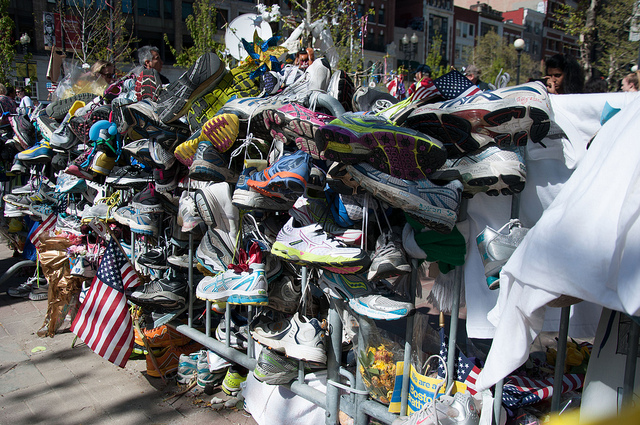Boston Strong Cause Marketing: The Good, The Bad & The Ugly
I can't believe it's already been a month since the Boston Marathon bombing. It was a harrowing day (and week with the ensuing man hunt), which I recounted in my newsletter and on the For Momentum blog. In the days following the bombing, Boston Strong became the battle cry for a whole nation.
On the cause marketing front, it was a interesting and enlightening to watch things unfold. I saw a lot of great examples of cause marketing that were innovative, creative and downright inspiring. It made me even prouder to be a wicked awesome Bostonian!
But there was also a downside to all the attention the tragedy got, and the mad rush to give when it wasn't always clear who was getting what and how much.
Here's my perspective on the good, the bad and the ugly of Boston Strong cause marketing.
The Good
One Fund Boston. State and city officials did a great job moving quickly to establish a single fund to which people could donate. In the aftermath of the bombing, people asked me where they should give. The Red Cross and the Salvation Army were doing good work at the scene of the bombing, but we needed a better alterative to help the victims. To date, the fund has collected $30 million from 50,000 donors.
Register programs and cause products. Immediately after the bombing I used a Pinterest to keep track of all the cause marketing partnerships created to help the victims. Honestly, I was blown away by all the tee shirts. They raised money and fueled Boston pride. This Boston Strong shirt created by two Emerson College students has raised almost a million dollars. Their initial goal was $1,500.
Beyond cause products, register programs quickly popped up at Boston businesses to collect money from customers and shoppers. One of these businesses, CVS Pharmacy, reported three weeks after the bombing that they had raised over $500,000 in one and three dollar increments.
The Bad
The downside of so much focus and money going to the marathon victims was how it impacted fundraising for other organizations. MassNonprofit.org reported on three such nonprofits.
- Project Bread, the only statewide anti-hunger organization in Massachusetts, raised $3.1 million through its annual Walk for Hunger this past Sunday, falling short of its goal by about a half million dollars.
- Run-Walk to Home Base, which provides clinical care and support to Iraq and Afghanistan veterans and families, raised $1.9 million through its fourth annual fundraiser last Saturday. Last year, the same event brought in slightly more, $2 million, although this year’s 2,100 participants mirrored last year’s number. In 2011, the Run-Walk raised $2.6 million.
- Longwood Giving a Brookline-based nonprofit that helps other nonprofits raise funds, netted $50,000 at its second annual Friends With Benefits Gala on April 25. That was nearly 40% off its $80,000 target, although attendance, at 320, increased by almost 30% over last year.
Cause marketing after the bombing reignited the debate on whether cause marketing - especially cause products - are appropriate after a tragedy. Mara Einstein wrote about this in After a Tragedy, the Conundrum of Corporate Donations. She asked why Adidas, which sold a shirt to benefit the victims and raised a million dollars, didn't just donate the money. The reason they chose to sell the shirt - and consumers bought it - says a lot about corporate giving, consumerism and how we deal with grief. I suggest you read Mara's article.
The question I had was different from Mara's. With all these tees and other products for the victims why weren't companies donating more than just the profits? Why not donate the whole amount? It's easy to give away profits you weren't expecting, but where's your donation?
The truth was that many companies did make an upfront donation. For example, Shaw's Supermarkets asked consumers to donate money at checkout, and even offered to match their gift up to $100,000. But they kicked off the effort with an immediate donation of $100k. I like their mix of philanthropy and cause marketing.
The Ugly
The ugly side of cause marketing is the magician's curtain some companies use to screen donation information. When will they learn? The Boston Globe reported on two "I dunno know" fundraisers for the victims.
- Yankee Candle's Boston Strong candle, which sells for $27.99. The Mass-based candle maker won't say how much will go to the victims or how much has been raised.
- Kenny Chesney is giving his share of money earned on single-track downloads of the song “Spread the Love” to bombing victims. But he won't say how much because his deal with distributors such as iTunes prohibit disclosure.
My cause marketing Pinterest board Support the Victims of the Boston Bombing features 83 products and services that benefit the victims. But the disclosure information on many items varies from missing in action to ambiguous ("A portion of funds raised") to confusing ("A portion of net proceeds"). Winston Churchill was right, "The inherent vice of capitalism is the unequal sharing of blessings."
In addition, who's keeping track of collections? Who really knows if the consumer's donation will reach the victims. The Massachusetts Attorney General certainly doesn't have the resources to track them all. My business, Selfish Giving, doesn't either.
Sadly, the generous people who bought products thinking that they were helping the victims could end up victims themselves.
Photo by Bradhoc via Flickr.

